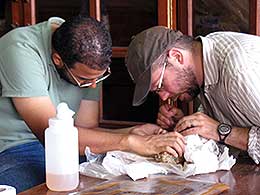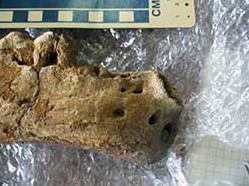UW Researcher Contributes to Discovery of Mick Jagger

It has super-sized lips like Mick Jagger, but is even older than the ancient rock star of the Rolling Stones.
An extinct swamp-dwelling, plant-munching creature that lived 19 million years ago in Africa has been named after the famous band’s lead singer. Mark Clementz, a University of Wyoming associate professor in the Department of Geology and Geophysics, was part of the discovery.
Clementz is among seven writers of a paper, titled “Anthracotheres From Wadi Moghra, Early Miocene, Egypt,” published in the Sept. 8 issue of the Journal of Paleontology. The journal publishes original articles and notes on the systematics, phylogeny, paleoecology, paleogeography and evolution of fossil organisms.
“As far as my contribution to the paper goes, I analyzed the stable isotopic composition of the teeth of this animal, which we used to interpret its diet and habitat preferences,” says Clementz, who is on sabbatical this year in Berlin, Germany.
Researchers from Duke University and Wake Forest University gave the creature the scientific name of Jaggermeryx naida, which means “Jagger’s water nymph.” The animal’s fossilized jaw bones suggest the creature was roughly the size of a small deer, and akin to a cross between a skinny hippopotamus and a long-legged pig.
Gregg Gunnell, a Duke University paleontologist and director of the Division of Fossil Primates at the Duke Lemur Center, says he is a huge Rolling Stones fan, and Jagger’s name took precedence over suggestions by other researchers, who wanted to name the new species after Hollywood actress Angelina Jolie.
“’Exile on Main Street’ and ‘Let it Bleed’ were my favorite albums,” Gunnell says of the two Rolling Stones classics.
Clementz says the research team looked at the oxygen isotopic composition of the tooth
enamel to determine how much time Jaggermeryx was spending in the water. Relative to other medium- and large-sized  mammals in the same area, modern hippos have much lower oxygen isotope values because
their body water more closely reflects that of the surface waters they live in rather
than the water in the grasses they consume on land.
mammals in the same area, modern hippos have much lower oxygen isotope values because
their body water more closely reflects that of the surface waters they live in rather
than the water in the grasses they consume on land.
“Jaggermeryx also had very low oxygen isotope values when compared to the rest of the fauna of the same age and location, which indicates this animal most likely spent as much time in the water as a modern hippo,” Clementz says.
According to a Wake Forest University media release, the creature belonged to a family of extinct hoofed animals called anthracotheres.Jaggermeryx is one of six species of anthracotheres found at a remote site in the Egyptian desert. The Jaggermeryx, compared to other members of the family, is distinguished by a series of tiny holes on either side of its jaw that held the nerves that provided sensation to its chin and lower lip.
“If you look at the dentary, or lower jaw, of Jaggermeryx, you'll see that it has several small holes, or mental foramina, at the anterior end, roughly where the chin and lower lips would be located,” Clementz says. “These holes would have allowed nerves to reach the lips. Given the number of holes, it’s a good bet this animal probably had large, sensitive lips, which could have helped it feed in muddy water.”
The Egyptian site where the fossils -- multiple jawbone fragments -- were found is predominantly desert today, but geological data suggest the area, millions of years ago, was a lush, tropical delta crisscrossed by rivers and swampland. The creature’s fossils were found alongside fossilized catfish, turtles, water birds and crocodile dung.
Preliminary measurements of the relative amounts of different isotopes in the animal’s bones suggest that it probably ate plants on land but, when not feeding, spent the rest of its time in the water, Clementz says.
The Jaggermeryx fossils now reside in collections at Duke University, the Cairo Geological Museum and Cairo University.
The research was supported by the National Science Foundation.
Lower left photo: The lower jawbone of Jaggermeryx Naida has several small holes, roughly where the chin and lower lips would be located. (Photo Ellen Miller)

